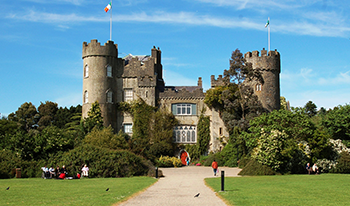The monastery of Clonmacnoise (Cluain Mhic Nóis in Irish, meaning Meadow of the Sons of Nós) is situated in County Offaly, Ireland on the River Shannon south of Athlone. It was visited by the Pope in 1979. The site can be visited for a fee, via an Interpretative Centre.
The modern village of Clonmacnoise is beside the monastery on the R444 regional road 7 km north of Shannonbridge, County Offaly.
Clonmacnoise was founded in 545 by Saint Ciarán in the territory of Ui Maine at the point where the major east-west land route through the bogs of central Ireland along the Eiscir Riada, an esker or moraine left by the receding glaciers of the last ice age crossed the River Shannon. Saint Ciarán had been educated by St. Finnian of Clonard and also by Abbot St. Enda of Aran.
Shortly after his arrival with eight companions, Ciarán met Diarmait mac Cerbaill who helped him build the first church — a small wooden structure and the first of many small churches to be clustered on the site. Diarmuid was to claim the title of the first Christian High King of Ireland. Ciaran died about one year later of the yellow plague and was buried reputedly in the building now known as Temple Ciaran; he was in his early thirties.
The strategic location of the monastery helped it become a major centre of religion, learning, craftsmanship and trade by the 9th century and together with Clonard it was the most famous in Ireland, being visited by scholars from all over Europe. Until the 9th century it had close associations with the kings of Connacht and then until the 11th century it was alliance with the kings of Mide. Many of the high kings of Tara and Connacht were buried here. It was attacked frequently, by the Vikings, Anglo-Normans and other Irish forces.
Clonmacnoise CastleAll the early buildings including churches were of wood and have not survived. They were replaced in stone by the tenth century onwards when Clonmacnoise became a bishopric. It also produced many fine examples of Celtic gold and silverware, which is preserved in Dublin museums.
After the 12th century it fell into decline. The English built a castle next to the monastery in the 13th century and the whole settlement was finally sacked in 1552 by an English garrison from Athlone which reduced it to a ruin.
Tours featuring this attraction
Peace of Mind Guarantee
Your trip, worry free!Our Ireland based team is on call throughout your vacation!

